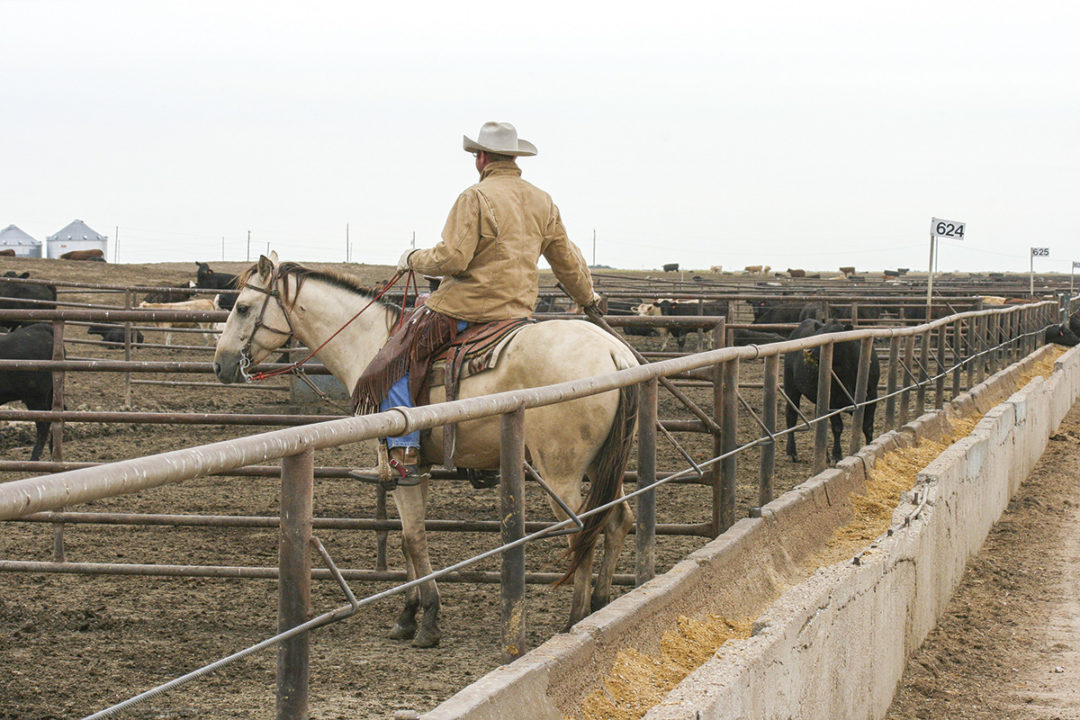“When you’re using horses in the feedyard, slower is faster,” Garry Watt of Watt Performance Horses in Sidney, Nebraska, says. “Go at a slower pace to help prevent mistakes. Be mindful of your horse’s training level, and don’t put them in a position where you end up asking too much of them. And always practice safety principles. I preach that every day.”
Having grown up on his family’s Nebraska ranch, working both cattle and horses, Watt has a lifetime of experience with both horses and riders in his feedyard.
Identifying pen rider safety principles is one of the aims of Central States Center for Agricultural Safety and Health (CS-CASH). This University of Nebraska Medical Center group is conducting two research projects (funded by the National Institutes of Occupational Safety and Health) that are designed to make a positive impact on the sustainability of cattle feedyards through increased safety and health efforts.
“Some horses and riders are better at working cattle in a feedyard than others,” Watt says. “Key safety principles for both horse and rider are staying in control of your actions and your horse.”
Feedlot managers must know the abilities of both riders and horses in order to avoid putting them in situations they aren’t equipped to handle. If necessary, the manager should be ready to provide training for either rider or horse to help them acquire necessary skills.
Neither riders nor managers should adopt a “cowboy” mindset that could lead to risky decisions and undertaking unnecessary chances.
Five basic principles of cattle behavior can help pen riders determine what an animal plans to do. Those behaviors include:
- Cattle want to see you.
- Cattle want to go around you.
- Cattle want to be with and will go to other cattle.
- Cattle want to return to where they have been, where they feel safe.
- Cattle can only process one main thought at a time.
“Cattle behaviors reveal what an animal is thinking or planning to do before they do it,” Watt says. “A skilled pen rider will recognize those behaviors and act accordingly before an animal can break and run, charge or act out in other dangerous ways.”
In a feedyard, if an animal does “escape,” it can’t go very far. Pen riders should respond to this kind of event calmly, knowing they can retrieve the animal somewhat easily and go on with their day.
Pen riders who grew up with horses and cattle may have a deeper understanding of cow behavior. However, anyone who wants to can learn to read how a cow is responding to its surroundings and have a good idea of what they will do.
In his own experience, if a rider struggles to read cattle behavior, Watt has sometimes taken inexperienced riders off their horse and put them on the ground to help them focus on what’s happening around them. Once they grasp subtle behavioral changes in either cattle or horses, riders more readily perceive animal attitudes.
“When you are on foot and work to move a cow around in a small pen, you’ll start to understand the mentality of that animal,” Watt says. “That’s a good way to determine if the problem with moving an animal lies with the horse or the rider.”
The horse’s abilities
Horses bred to work cattle more readily understand cow behavior. Some horses may never develop that ability.
“When you have a skilled horse, stay out of their way; they’ll do a lot for you,” Watt says. “Horses who just don’t grasp cow mentality may continue to struggle.”
Riders working in a feedyard have many factors to keep in mind as they work. For that reason, working at a steady, disciplined pace will benefit both riders and horses. Often, a rider will need to intuitively know how their horse will respond to specific situations. While one horse may remain calm in a certain situation, another may panic and blow up.
Understanding footing conditions a horse is working on – wet, muddy, icy, etc. – is important to knowing what the rider can ask the horse to do. If they need to move quickly or turn sharply, footing conditions will affect their ability and stability.
In general, pen riders will be safer if they adopt an attitude of working slowly and correctly as they learn to work animals. Doing so will reinforce safe behaviors and speed will come over time.
Training and roles
“There may be times when a rider continues to struggle with grasping what’s happening in their surroundings,” Watt says. “In that case, a manager should determine if that person needs to work in a different role in the feedyard.”
Watt notes that anyone can encounter a dangerous situation when working cattle, regardless of their length of experience.
“I had a cow run me down an alley,” he says. “I knew she was a cranky animal, but I believed I could walk among the herd she was in and open a gate so I could move them. First thing I knew, she was coming at me, about 25 or 30 feet away. I ran down that alley as fast as I could. I was all by myself, so that could have been a tragic situation. She could have hurt me pretty badly. Anytime you work cattle, you have to be mindful of things like that, which could happen.”
Watt believes well-trained managers who thoroughly understand cattle behavior, horses and the skills required to safely work in a feedyard, can be a great asset to their employer.
“It takes a lot of groundwork to get a horse and a rider ready to work in a feedyard,” he says. “Sometimes you don’t have the luxury of taking that time. In that case, you have to get the best sense of what a horse and a rider is capable of and start at that point. Some riders will crave new information and others may resist advice.
“There’s always room for improvement on feedyard horses,” Watt says. “Even older horses that are high strung – by being careful what you ask them to do, not working them in a gruff manner, you can settle them down over time.”









